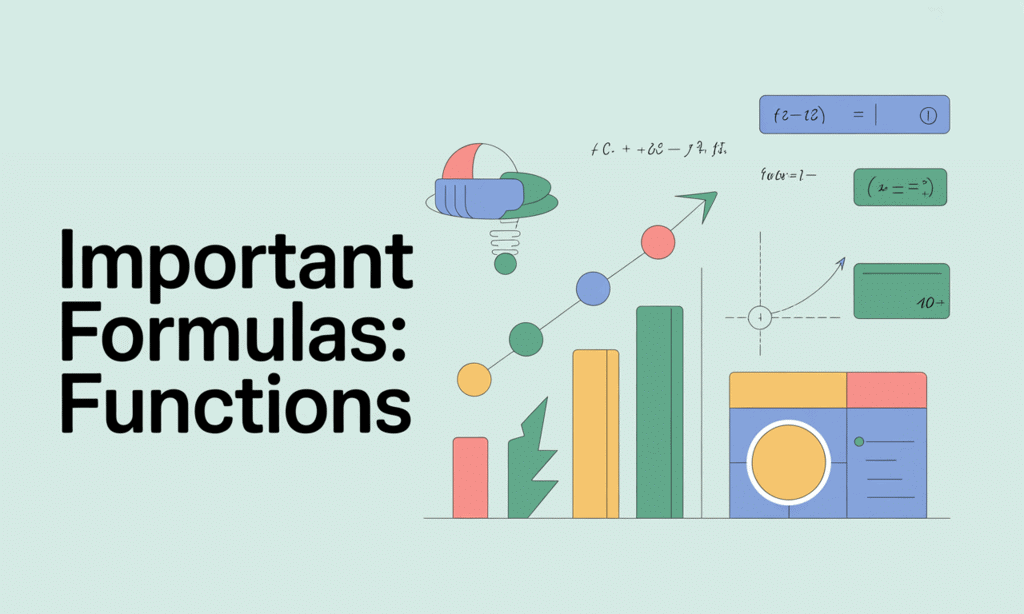Important Formulas: Functions | Quantitative Aptitude (Quant) - CAT PDF Download
| Table of contents |

|
| Definition of a Function |

|
| Standard Function Forms |

|
| Function Operations |

|
| Composition of Functions |

|
| Inverse Functions |

|
| Special Properties |

|
| Tricks for CAT |

|

Functions describe a relationship between inputs and outputs. Understanding functions is essential for solving problems on composition, inverses, transformations, and algebraic manipulations.
Definition of a Function
A function f from a set X to a set Y is a rule that assigns exactly one element y ∈ Y to each x ∈ X, denoted as f(x) = y.
Domain: Set of all possible input values (x).
Range: Set of all possible output values (f(x)).
Types of Functions
One-to-One (Injective): Each element of the domain maps to a unique element of the range.
Onto (Surjective): Every element of the range has a pre-image in the domain.
Bijective: Function that is both one-to-one and onto; only bijective functions have inverses.
Standard Function Forms
Linear Function: f(x) = mx + c
- Domain: ℝ
- Range: ℝ
- Graph: Straight line, slope m, intercept c
Note: The symbol ℝ represents the set of all real numbers (positive, negative, and zero, including fractions and decimals).
Quadratic Function: f(x) = ax² + bx + c, a ≠ 0
Domain: ℝ
Range:
a > 0 → [minimum at vertex, ∞)
a < 0 → (−∞, maximum at vertex]
Vertex: x = −b/(2a)
Value at vertex: f(−b/2a) = −Δ/(4a), where Δ = b² − 4ac
Absolute Value Function: f(x) = |x|
- Domain: ℝ
- Range: [0, ∞)
- Property: f(x) ≥ 0
Identity Function: f(x) = x
- Domain: ℝ
- Range: ℝ
Constant Function: f(x) = c
- Domain: ℝ
- Range: {c}
Function Operations
- Sum: (f + g)(x) = f(x) + g(x)
- Difference: (f − g)(x) = f(x) − g(x)
- Product: (f × g)(x) = f(x) × g(x)
- Quotient: (f ÷ g)(x) = f(x) ÷ g(x), g(x) ≠ 0
Composition of Functions
(f ∘ g)(x) = f(g(x))
- Domain: All x ∈ Domain(g) such that g(x) ∈ Domain(f)
- Example: f(x) = x², g(x) = x + 1 → (f ∘ g)(x) = f(g(x)) = (x + 1)²
Property: (f ∘ g) ≠ (g ∘ f) in general
Inverse Functions
f⁻¹(x) reverses the mapping of f(x).
Condition: f must be bijective to have an inverse.
Property: f(f⁻¹(x)) = f⁻¹(f(x)) = x
Finding an inverse:
Write y = f(x)
Solve for x in terms of y
Swap x and y → x = f⁻¹(y)
Example:
f(x) = 2x + 3 → y = 2x + 3 → x = (y − 3)/2 → f⁻¹(x) = (x − 3)/2
Special Properties
Even Function: f(−x) = f(x) → symmetric about the y-axis
Odd Function: f(−x) = −f(x) → symmetric about the origin
Periodic Function: f(x + p) = f(x) → p is the period
Tricks for CAT
- To simplify composite functions: substitute the inner function first.
- For inverses: always verify f⁻¹(f(x)) = x.
- For quadratic and absolute value functions: check vertex and domain restrictions.
- Recognise even/odd/periodic properties to avoid unnecessary calculation.
|
167 videos|229 docs|95 tests
|
FAQs on Important Formulas: Functions - Quantitative Aptitude (Quant) - CAT
| 1. What is the definition of a function in mathematics? |  |
| 2. What are the standard forms of functions that students should know? |  |
| 3. How can function operations such as addition, subtraction, multiplication, and division be performed? |  |
| 4. What is the composition of functions and how is it calculated? |  |
| 5. What are inverse functions and how can one determine if two functions are inverses of each other? |  |



















